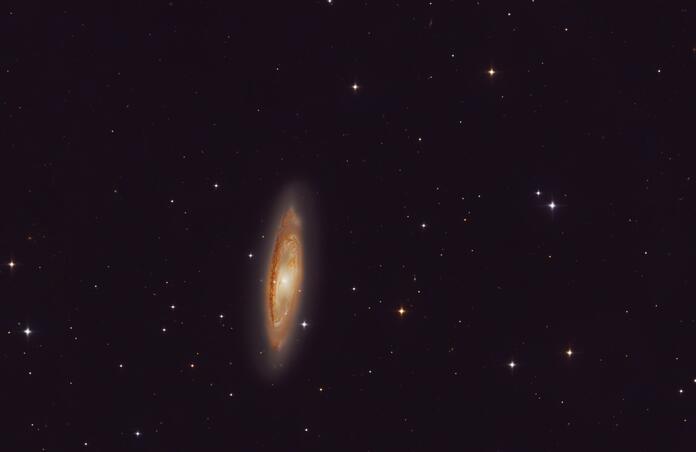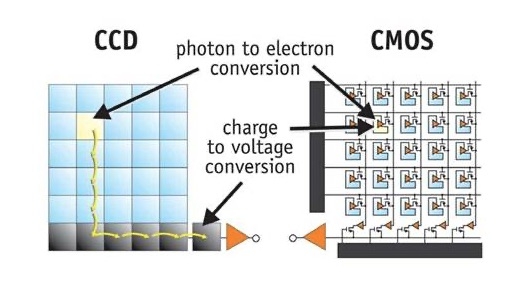Using a CMOS Camera

Marco Rocchetto announced on Telescope Live recently that the Charged Coupled Device (CCD) cameras we’ve been using on the platform up to this point will be upgraded to Complimentary Metal Oxide Semiconductor (CMOS) cameras. Specifically, the upgrade will be to phase out the Finger Lakes Instrumentation series CCD cameras and install the QHY 600M series CMOS cameras.
This will be an improvement to the quality of the data we’ll soon have access to. As astrophotographers, we should understand what this change means and how to best exploit it. The bottom line question is, what does this switch mean for me as a deep sky imager? I’ll try to provide a brief answer to that question, but you should read Ron Brecher’s excellent article in the March 2023 issue of Sky and Telescope to get a very detailed answer to this question. I’ll paraphrase and use some of the information contained in that article.
In general, CCD and CMOS cameras are pretty similar; they both use pixels to record photons striking them which in turn generate electrons that are converted into a digital signal and captured as data in your computer. Improvements in CMOS technology over the past several years to improve their sensitivity to light, i.e. grab as many photons as possible has allowed CMOS cameras to reach parity with CCDs in the quantum efficiency measure.
Where CMOS cameras excel over CCD cameras is with noise reduction. CMOS cameras have much less read noise than their CCD counterparts. This drop in noise level means that with a CMOS camera, you should be able to stack many short exposures (1 minute or less) and have much less noise and no degradation of quality when compared to a stack of longer exposures (5 to 10 minutes) taken on a CCD camera.
Another problem, amplifier glow, has been a major issue for both types of cameras. Amplifier glow or simply amp glow refers to a glow you would get in an image generally caused by the heat from the readout circuitry of the imaging chip. For CCD cameras, this was generally caused by the signal amplifier that, with the rest of the chip’s circuitry was located on the chip frame. However, for CMOS cameras the circuitry is integrated with the pixels on the sensor. Each pixel has the Analog to Digital Converter (ADC), clock generators and other circuitry integrated within it. In both cases, the circuitry can generate heat and Near Infrared light which and expands over to the light sensitive area of the chip and it becomes visible as an unwanted artifact in your images.

Amp glow has been seriously reduced in the latest generation of CMOS cameras such as the QHY 600M that Telescope Live is upgrading its equipment with, to where the problem is pretty much non existent.
There are 2 other differences that will have consequences that you as an astrophotographer should understand. The first is pixel size; CCDs usually have very large pixels - 6 microns or larger. A good example is the FLI PL 9000 camera that has been used on the CHI-1 Planewave CDK24 telescope. The pixel size for this camera is 12 microns. The pixel size on the QHY 600M camera is 3.76 microns. Usually larger pixels mean you’ll get more light gathering capacity with a CCD camera. However, because read noise is a lot less for CMOS cameras along with newer technology that can steer more light directly to a pixel, the difference in the capacity to gather light is a lot smaller. Resolution, however can be greatly increased as pixel size affects the resolution that can be obtained from the optical train. The move to the QHY 600M should noticeably improve the resolution and image scale for the equipment it’s used on. To determine this, we need to know the size of the pixel array of our camera image sensor and translate the angular size of the smallest details the sensor will be able to see. The base measure for this is usually given in arc seconds per pixel. To maximize resolution, you’ll need pixel sizes to be small enough to pick up the smallest details that can be picked up using 2 linked pixels or more.
To calculate the angular size of a pixel, we need to use the following equation:
= 206265 x [Camera Pixel Size / Telescope Focal Length]
The QHY 600M camera’s pixel size is 3.76 microns or .00376mm. The Planewave CDK24 (CHI-1) has a focal length of 3,962 mm. Do the math and the angular pixel size for this setup is 0.1957 arc seconds per pixel. In other words, for the given field of view of this setup, each pixel will cover about 0.2 arc second of detail in the image which would be outstanding resolution. However, as Marco explained in the announcement, the single file size would be huge and somewhat impractical. It would also not be reasonable to expect this kind of performance because it would exceed the sky conditions normally seen at the imaging site in the Rio Hurtado Valley in Chile. This is why binning will be used; 2x2 binning (4 pixels combined) would provide an image scale of 0.78 arc seconds per 2x2 binned pixel, much closer to the 1 arc second per pixel seeing that is generally found at this imaging site.
Probably the biggest difference between CCDs and CMOS cameras is how data is read after capturing it. For CCDs, the data has to be transferred in columns to an amplifier and the ADC where both are located off the chip. This makes for slow image download speeds, generally 15 to 20 seconds for each sub exposure. For CMOS, each pixel has an amplifier and the ADC is located on the chip at the end of each column.

This makes download speeds much faster; in my experience with the QHY 268C or QHY 294M CMOS cameras that I use, sub exposure downloads are less than 5 seconds on average. The downloading time difference between CCD and CMOS can theoretically allow for an additional sub exposure to be taken for each hour of imaging time than what we’re getting now.
All in all, I expect the move to the QHY 600M camera is going to provide greater image resolution and reduced noise in the data we’ll get. The fast download speeds will improve the efficient use of the equipment and give us more opportunities to get more data in the same amount of imaging time.
I’ve attached links to the specifications for the QHY 600M camera here.
The specifications for the FLI PL 9000 being replaced is here.
Image Credits
M65; 1-Click Observation, Telescope Live CHI-1 CCD (FLI PL 9000) LRGB, Processed in PixInsight
CCD Architecture vs CMOS Architecture; https://meroli.web.cern.ch/lecture_cmos_vs_ccd_pixel_sensor.html
